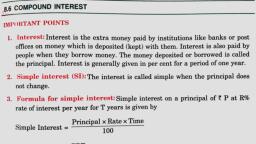Question 1 :
Find the sum of the first 15 terms in $a_n = 3 + 4n$.
Question 2 :
If the sum of the first n terms of an AP is $4n – n^2$, What is the 10th term ?
Question 3 :
In an AP, given $a_3 = 15, S_{10} = 125$, find d and $a_{10}$.
Question 5 :
Find the number of terms in the following AP :18, 15.5, 13, . . . , – 47
Question 6 :
If the sum of the first n terms of an AP is $4n – n^2$, What is the nth term ?
Question 7 :
Find the sum of first 22 terms of an AP in which d = 7 and 22nd term is 149.
Question 8 :
Find the sum of the following AP: –5 + (–8) + (–11) + . . . + (–230)
Question 9 :
In an AP, given $a = 2, d = 8, S_n = 90$, find n and $a_n$.
Question 10 :
<img style='object-fit:contain' src='https://teachmint.storage.googleapis.com/question_assets/cbse_ncert/61b19bc3273b230584979a0e.JPG' />
In the above fig, find the missing value corresponding to (iii)
Question 11 :
Find the sum of the odd numbers between 0 and 50.
Question 13 :
The first and the last terms of an AP are 17 and 350 respectively. If the common difference is 9, how many terms are there in the AP?
Question 14 :
Find the sum of the following AP: –37, –33, –29, . . ., to 12 terms.
Question 15 :
Which term of the AP : 3, 15, 27, 39, . . . will be 132 more than its 54th term?
Question 16 :
Determine the AP whose third term is 16 and the 7th term exceeds the 5th term by 12.
Question 17 :
In an AP, given l = 28, S = 144, and there are total 9 terms. Find a.
Question 18 :
In an AP, given $a_n = 4, d = 2, S_n = –14$, find n and a.
Question 19 :
Subba Rao started work in 1995 at an annual salary of Rs. 5000 and received an increment of Rs. 200 each year. In which year did his income reach Rs. 7000?
Question 20 :
Does $a_1, a_2, . . ., a_n, . . $ form an AP where $a_n = 9 – 5n$?
Question 21 :
If the sum of the first n terms of an AP is $4n – n^2$, what is the first term (that is $S_1$)?
Question 22 :
<img style='object-fit:contain' src='https://teachmint.storage.googleapis.com/question_assets/cbse_ncert/61b19bc4273b230584979a10.JPG' />
In the above fig, find the missing value corresponding to (i)
Question 23 :
Find the sum of first 51 terms of an AP whose second and third terms are 14 and 18 respectively.
Question 24 :
Find the sum of the following AP: 0.6, 1.7, 2.8, . . ., to 100 terms.
Question 25 :
Find the sum of the first 40 positive integers divisible by 6.
Question 26 :
An AP consists of 50 terms of which 3rd term is 12 and the last term is 106. Find the 29th term.
Question 27 :
<img style='object-fit:contain' src='https://teachmint.storage.googleapis.com/question_assets/cbse_ncert/61b19bc9273b230584979a16.JPG' />
In the above fig. A ladder has rungs 25 cm apart. The rungs decrease uniformly in length from 45 cm at the bottom to 25 cm at the top. If the top and the bottom rungs are $2\frac{1}{2}$ m apart, what is the length of the wood required for the rungs?
Question 28 :
If the sum of first 7 terms of an AP is 49 and that of 17 terms is 289, find the sum offirst n terms.
Question 29 :
The houses of a row are numbered consecutively from 1 to 49. Show that there is a value of x such that the sum of the numbers of the houses preceding the house numbered x is equal to the sum of the numbers of the houses following it. Find this value of x.
Question 30 :
The first term of an AP is 5, the last term is 45 and the sum is 400. Find the number of terms and the common difference.
Question 31 :
<img style='object-fit:contain' src='https://teachmint.storage.googleapis.com/question_assets/cbse_ncert/61b19bc8273b230584979a15.JPG' />
In the above fig. In a potato race, a bucket is placed at the starting point, which is 5 m from the first potato, and the other potatoes are placed 3 m apart in a straight line. There are ten potatoes in the line. A competitor starts from the bucket, picks up the nearest potato, runs back with it, drops it in the bucket, runs back to pick up the next potato, runs to the bucket to drop it in, and she continues in the same way until all the potatoes are in the bucket. What is the total distance the competitor has to run?
Question 32 :
Find the sum of the following AP: $\frac{1}{15}, \frac{1}{12}, \frac{1}{10}, . .$ , to 11 terms
Question 33 :
How many terms of the AP : 9, 17, 25, . . . must be taken to give a sum of 636?
Question 34 :
The first and the last terms of an AP are 17 and 350 respectively. If the common difference is 9, what is the sum of the AP?
Question 35 :
The 17th term of an AP exceeds its 10th term by 7. Find the common difference.
Question 36 :
<img style='object-fit:contain' src='https://teachmint.storage.googleapis.com/question_assets/cbse_ncert/61b19bc6273b230584979a13.JPG' />
In the above fig. A spiral is made up of successive semicircles, with centres alternately at A and B, starting with centre at A, of radii 0.5 cm, 1.0 cm, 1.5 cm, 2.0 cm, . . . as shown in above figure. What is the total length of such a spiral made up of thirteen consecutive semicircles?
Question 37 :
Find the 31st term of an AP whose 11th term is 38 and the 16th term is 73.
Question 38 :
In an AP, given a = 5, d = 3, $a_n$= 50, find n and $S_n$.
Question 39 :
Check whether – 150 is a term of the AP : 11, 8, 5, 2 . . .
Question 40 :
Does $a_1, a_2, . . ., a_n, . . $ form an AP where $a_n = 3 + 4n$?
Question 42 :
Ramkali saved Rs. 5 in the first week of a year and then increased her weekly savings by Rs. 1.75. If in the nth week, her weekly savings become Rs. 20.75, find n.
Question 43 :
In an AP, given $a_{12} = 37, d = 3$, find a and $S_{12}$.
Question 44 :
If the sum of the first n terms of an AP is $4n – n^2$, What is the 2nd term ?
Question 45 :
In an AP, given $a = 8, a_n = 62, S_n = 210$, find n and $d$.
Question 46 :
In an AP, given $a = 3, n = 8, S = 192$, find d.
Question 47 :
The sum of the third and the seventh termsof an AP is 6 and their product is 8. Find the sum of first sixteen terms of the AP.
Question 48 :
If the sum of the first n terms of an AP is $4n – n^2$, What is the 3rd term ?
Question 49 :
For what value of n, are the nth terms of two APs: 63, 65, 67, . . . and 3, 10, 17, . . . equal?
Question 50 :
<img style='object-fit:contain' src='https://teachmint.storage.googleapis.com/question_assets/cbse_ncert/61b19bc7273b230584979a14.JPG' />
In the above fig. 200 logs are stacked in the following manner: 20 logs in the bottom row, 19 in the next row, 18 in the row next to it and so on. In how many rows are the 200 logs placed and how many logs are in the top row?








































